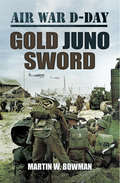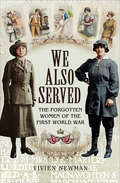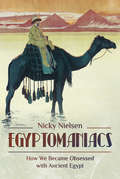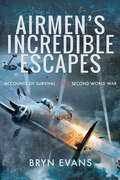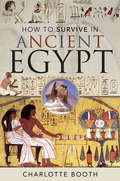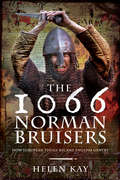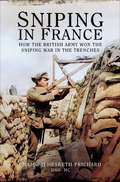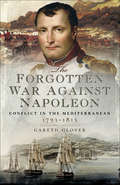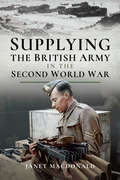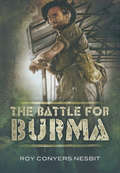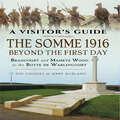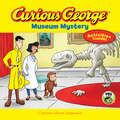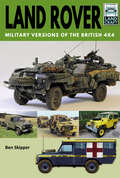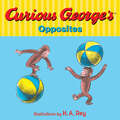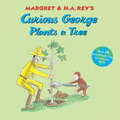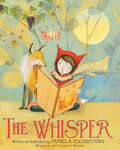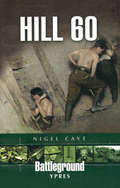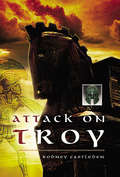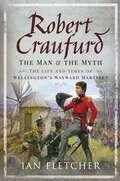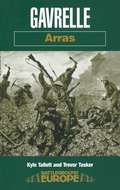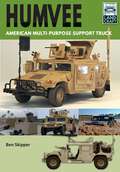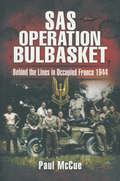- Table View
- List View
Two-dimensional Product Cubic Systems, Vol. VII: Self- Quadratic Vector Fields
by Albert C. LuoThis book is the seventh of 15 related monographs, concerns nonlinear dynamics and singularity of cubic dynamical systems possessing a product-cubic vector field and a self-univariate quadratic vector field. The equilibrium singularity and bifurcation dynamics are discussed. The saddle-source (sink) is the appearing bifurcations for saddle and source (sink). The double-saddle equilibriums are the appearing bifurcations of the saddle-source and saddle-sink, and also the appearing bifurcations of the network of saddles, sink and source. The infinite-equilibriums for the switching bifurcations include: • inflection-saddle infinite-equilibriums, • hyperbolic-source (sink) infinite-equilibriums, • up-down (down-up) saddle infinite-equilibriums, • inflection-source (sink) infinite-equilibriums.
Gold Juno Sword: Volume 5 (Air War D-Day #5)
by Martin W. BowmanThis is the final volume of a comprehensive five part work, including a multitude of personal accounts of every aspect of the aerial operations on 'Gold' 'Juno and 'Sword' beaches during D-Day. It relays the sense of relief experienced as Allied troops gained a foothold on the continent of Europe after D-Day, both by the men caught up in the proceedings and the jubilant civilians on the home front. By the end of June 875,000 men had landed in Normandy; 16 divisions each for the American and British armies. Although the Allies were well established on the coast and possessed all the Cotentin Peninsular, the Americans had still not taken St Lo, nor the British and Canadians the town of Caen, originally a target for D-Day. German resistance, particularly around Caen was ferocious, but the end result would be similar to the Tunisian campaign. More and more well-trained German troops were thrown into the battle, so that when the Allies did break out of Normandy, the defenders lost heavily and lacked the men to stop the Allied forces from almost reaching the borders of Germany. In continuing style, Bowman pays respect to the men who fought in the skies above France on D-Day. This episode of Aviation history has never before been the focus of such detailed analysis; the five volumes of this series act as a memorial to the individuals who played their own individual parts in the wider proceedings. Far from being a mere operational record, this is the story of the men behind the headlines, the reality behind the iconic images of parachute drops and glider formations.
We Also Served: The Forgotten Women of the First World War
by Vivien NewmanA social history of British women&’s brave yet forgotten service during WWI from a historian of female wartime experiences—includes photos. At the outbreak of World War I, women looking to contribute to the Allied effort were told by the war office to &“go home and sit still.&” Thankfully, hundreds of thousands of women from all corners of society ignored that advice and lent their collective strength to the cause. In We Also Served, Vivien Newman digs beneath the myths surrounding women&’s war efforts to reveal stories of determination and heroism. Becoming nurses, munitions workers, members of the Land Army, ambulance drivers, and surgeons, women stepped readily into a world normally occupied by men. Some served with the Armed Forces, others funded and managed their own hospitals within sight and sound of the guns. At least one British woman bore arms, and over a thousand women lost their lives as a direct result of their involvement with the war. This profoundly important history by an expert in female wartime experiences lets these all but forgotten voices finally be heard. &“A short book rich in facts and personal testimonies.&” —Historical Novel Society
Egyptomaniacs: How We Became Obsessed with Ancient Epypt
by Nicky NielsenAn examination of the popular view of ancient Egypt as an exotic, esoteric, and mystical culture that questions if that view is entirely accurate.The Greek historian Hecataeus of Abdera declared during the 4th century BCE that the Egyptian civilization was unsurpassed in the arts and in good governance, surpassing even that of the Greeks. During the Renaissance, several ecclesiastical nobles, including the Borgia Pope Alexander VI claimed their descent from the Egyptian god Osiris. In the 1920s, the discovery of Tutankhamun’s tomb in the Valley of the Kings prompted one of the first true media frenzies in history. For thousands of years, the Pharaonic culture has been a source of almost endless fascination and obsession. But to what extent is the popular view of ancient Egypt at all accurate?In Egyptomaniacs: How We Became Obsessed With Ancient Egypt, Egyptologist Dr. Nicky Nielsen examines the popular view of Egypt as an exotic, esoteric, mystical culture obsessed with death and overflowing with mummies and pyramids. The book traces our obsession with ancient Egypt throughout history and methodically investigates, explains and strips away some of the most popular misconceptions about the Pharaohs and their civilization.Praise for Egyptomaniacs“I have always been attracted to and fascinated by Ancient Egypt. In this superb book, Nicky Nielsen explains why we are so caught up in what happened in Ancient Egypt.” —Books Monthly (UK)
Airmen's Incredible Escapes: Accounts of Survival in the Second World War
by Bryn EvansHarrowing true stories of WWII Allied airmen who were shot down and survived, with maps and photos included.Allied air power made a major, arguably decisive, contribution to victory in the Second World War both in the European and Pacific theaters. But the cost in men and machines was horrific, with Bomber Command suffering 50% aircrew casualties. While many perished, others—shot down over enemy territory or water—survived only after overcoming extraordinary danger and hardship. Their experiences often remained untold, not just for the duration of the war but for many years.In this book, Bryn Evans has gathered together a wealth of unpublished stories from airmen of many nationalities, be they British, Commonwealth, or American. Some involve avoiding or escaping from capture, others surviving against all the odds, braving extreme elements and dodging death from wounds, drowning, or starvation.Importantly, the accounts of those who survived the battle in the skies cheating the enemy and the grim reaper give us a chilling insight into the fate of the many thousands of brave young men who were not so fortunate. The result is an inspiring and gripping read which bears testimony to human courage and resilience.
How to Survive in Ancient Egypt
by Charlotte BoothWhat would it be like if you were transported back to Thebes, 1360 BCE? This time-traveler’s guide is a fascinating way to find out . . . Imagine you were transported back in time to Ancient Egypt and you had to start a new life there. What would you see? How would the people around you think and believe? How would you fit in? Where would you live? What would you eat? Where would you go to have your hair done, or get help if you got ill or were mugged in the street? All these questions, and many more, are answered in this engaging blend of self-help and survival guide that plunges you into this historical environment—and explains the many problems and strange new experiences you would face if you were there.
The 1066 Norman Bruisers: How European Thugs Became English Gentry
by Helen KayThe fascinating story of the social evolution of William the Conqueror’s invaders and the generations that followed: “A great book.” —Medieval Sword SchoolThe 1066 Norman Bruisers conjures up the vanished world of England in the late Middle Ages and casts light on one of the strangest quirks in the nation’s history: how a bunch of European thugs became the quintessentially English gentry. In 1066, go-getting young immigrant Osbern Fitz Tezzo crossed the Channel in William the Conqueror’s army. Little did he know that it would take five years to vanquish the English, years in which the Normans suffered almost as much as the people they had set out to subdue. For the English, the Norman Conquest was an unmitigated disaster, killing thousands by the sword or starvation. But for Osbern and his compatriots, it brought territory and treasure—and a generational evolution they could never have imagined. This book follows successive descendants as they fought for monarchs and magnates, oversaw royal garrisons, traveled abroad as agents of the crown, and helped to administer the laws of the land. When they weren’t strutting across the stage of northwestern England, mingling with great men and participating in great events, they engaged in feuds, embarked on illicit love affairs, and exerted their influence in the small corner of the country they had made their own. The 1066 Norman Bruisers represents both a fascinating family history and a riveting journey through post-Conquest England.
Sniping in France: How the British Army Won the Sniping War in the Trenches
by H. Hesketh-PrichardAvailable for the first time in years, this is a new edition of the classic account by the adventurer and big game hunter who developed and ran the British Army sniping programme in the First World War. When the war started in 1914, Germany's edge in the sniping duel on the Western Front cost thousands of British casualties. Sniping in France explains the methods Hesketh-Prichard used to reverse the situation and help win the sniping war. A glossary of terms and a photograph of the author have been added.
The Forgotten War Against Napoleon: Conflict in the Mediterranean, 1793–1815
by Gareth Glover&“A comprehensive look at the Mediterranean and adjacent territories, a largely &‘forgotten&’ theatre of the very long Anglo-French war.&” —New York Military Affairs Symposium The campaigns fought against Napoleon in the Iberian Peninsula, in France, Germany, Italy and Russia and across the rest of Europe have been described and analyzed in exhaustive detail, yet the history of the fighting in the Mediterranean has rarely been studied as a separate theater of the conflict. Gareth Glover sets this right with a compelling account of the struggle on land and at sea for control of a region that was critical for the outcome of the Napoleonic Wars. The story of this twenty-year conflict is illustrated with numerous quotes from a large number of primary sources, many of which are published here for the first time. &“This is a well researched and well written account of the most complex long term military commitment for Britain during the Napoleonic Wars, involving multiple theatres spread out over a large area, cooperation between the Navy and the Army, an ever changing cast of senior officers, opponents and allies, often made more complex by the time taken to get messages from London to the officers in the field.&” —History of War
Supplying the British Army in the Second World War
by Janet MacdonaldThe noted military historian reveals the fascinating history of British Army logistics during WWII in this scholarly study.Armies have always required large amounts of material, but by the Second World War the numbers of men involved had grown exponentially, their equipment had become mechanized, and their deployment was global. Elaborate planning and administration at every level had to ensure that items of all kinds were collected, transported and handed out in every theatre of the war. But how were these items selected, ordered, produced, and delivered? Following her previous volume, Supplying the British Army in the First World War, Janet MacDonald continues her study of how the British Army kept its soldiers fed, clothed, and ready to fight. The scale of the operation was enormous, and it had to be performed to critical timetables. Often threatened by enemy action, it was vital to the army’s success. MacDonald describes the necessity for central advanced planning for each expeditionary force as well as those engaged in home defense. She then elucidates the complex organization of personnel who performed these tasks, from the government and military command in London to those who distributed the equipment on the battlefield.
The Battle for Burma
by Roy Conyers NesbitThe struggle of British, Commonwealth and American-Chinese troops against the Japanese in Burma was one of the decisive campaigns of the Second World War. British India was threatened by the Japanese advance, the fate of the British Empire in the East hung in the balance. The tropical climate dense malarial jungle infested with vermin and swept by monsoon rains made the fighting, for both sides, a remarkable feat of arms. Yet the war in Burma rarely receives the attention it deserves. Roy C. Nesbit, in this highly illustrated account, traces the entire course of the campaign. In vivid detail he describes the British retreat and humiliation at the hands of the Japanese invaders in 1942. The Japanese were fanatical and trained in jungle warfare, well-equipped and backed with an overwhelming air power. The Allied response was to build up their forces on a massive scale eventually over 1,300,000 personnel were involved and to train them to fight in the jungle conditions. Their counter-offensive, launched in 1944, culminated in the battles at Imphal and Kohima which turned the course of the conflict, and the reconquest of Burma was achieved just before the atom bomb was dropped.
The Somme 1916—Beyond the First Day: Beaucourt and Mametz Wood to the Butte de Warlencourt (A Visitor's Guide)
by Jon Cooksey Jerry MurlandIn their second Visitor’s Guide to the 1916 Battle of the Somme Jon Cooksey and Jerry Murland focus on the series of secondary battles that were key stages in the five-month struggle that followed the start of the offensive on 1 July. They take the visitor – and the reader – across the entire battlefield, covering in graphic detail sites where actions took place that are almost as famous as the Somme itself in the history of the First World War, including Mametz Wood, High Wood, Deville Wood, Guillemont, Ginchy, Pozieres and Flers. They also provide tours of the less-well-known but equally interesting sites which played important parts in the offensive as a whole. In a sequence of routes that can be walked, biked or driven they describe what happened in each place, identify the units involved, highlight the experience and exploits of individual soldiers, and point out the notable sights, monuments and cemeteries. This highly illustrated guidebook is essential reading for visitors who wish to enhance their understanding of the Battle of the Somme and the war on the Western Front. It is also the ideal companion volume to The First Day of the Somme: Gommecourt to Maricourt by the same authors.
Napoleon's Army in Russia: The Illustrated Memoirs of Albrecht Adam, 1812
by Jonathan NorthIn 1812 Napoleon's magnificent army invaded Russia. Among the half a million men who crossed the border was Albrecht Adam, a former baker, a soldier and, most importantly for us, a military artist of considerable talent. As the army plunged ever deeper into a devastated Russia Adam sketched and painted. In all he produced 77 colour plates of the campaign and they are as fresh and dramatic as the day they were produced. They show troops passing along dusty roads, bewildered civilians, battles and their bloody aftermath, burning towns and unchecked destruction. The memoirs which accompany the plates form a candid text describing the war Adam witnessed. Attached to IV Corps, composed largely of Italians, he was present at all the major actions and saw the conquerors march triumphantly into Moscow. But, from then on, the invading army's fate was sealed and the disastrous outcome of the war meant that the year 1812 would become legendary as one of the darkest chapters in history.
Curious George Museum Mystery (CGTV)
by H.A. ReyGeorge plays detective to find a missing dinosaur bone, in a delightful story based on the animated series now streaming on Peacock! The science museum is unveiling a new dinosaur skeleton, but the skeleton is one bone short of being complete. Curious George and his friend the man with the yellow hat must use clues to retrace their path and solve the mystery of the missing bone — before it&’s too late! Based on Curious George, the Emmy Award-winning PBS TV show, this storybook also includes an order-of-events activity and game for readers to retrace their own steps just like George.
Land Rover: Military Versions of the British 4x4 (LandCraft)
by Ben SkipperA richly illustrated guide to modeling the military Land Rover, filled with previously unseen inspirational photographs and drawings.The Land Rover was originally designed to fill a gap in the Rover Car Company’s post-war product portfolio. Initially based on Willy’s-Overlands Jeep, the now-legendary Land Rover was adopted by armed forces across the globe almost immediately. By its sixtieth anniversary in 2008 the Land Rover was serving as a combat vehicle and as a first responder platform.This unique LandCraft title looks into the Land Rover’s development during the immediate post-war years, to its development and growth as a military vehicle synonymous with versatility. The book charts how the Land Rover evolved into unique military-only variants.The book also examines how this modest 4x4 grew from an innocuous Cold War cargo vehicle into a weapons platform supporting troops in the deserts of South West Asia. The military Land Rover truly offers the modeler an exciting range of subject, era and theatre choices.“A welcome addition to the very popular Land Craft Series. Aimed at model makers, this series has become popular with a much wider readership, due to the excellent text describing the subject vehicle and its deployment, including unit structures—Very Highly Recommended.” —Firetrench“All in all this is a great, compact reference work for modelers heading off on a Land Rover safari. It’s not overwhelming, provides good recommendations and fair assessments of products while presenting fantastic reference material to help the modeler get motivated and also providing enough up close detail to be helpful.” —AMPS
Curious George's Opposites (Curious George)
by H.A. Rey&“Very nice…a series of scenes featuring the mischievous monkey that illustrate concepts, such as up, down; in front, behind; dry, wet; and so forth.&”—Publishers Weekly Riding forward and backward on his bicycle and letting pigs in and out of their pen, George, in his typical inquisitive manner, explores opposites in this simple, humorous book featuring classic illustrations from the original series by H.A. Rey and Margret Rey and starring the &“adorable but trouble-making&” monkey beloved by generations of children (Forbes).
Curious George Plants a Tree (Curious George)
by Margret Rey H.A. ReyGeorge goes green! &“This picture book offers young children an appealing introduction to reusing and recycling.&”—Booklist George loves to go to the science museum. So, when he finds out that the museum is planning a &“Green Day&” dedicated to recycling and planting trees, George is curious and wants to help out! But little monkeys eager to help can sometimes become little monkeys getting into trouble. When George begins to find and recycle things around town that aren&’t quite ready for the recycle bin, he gets into a jam. Thankfully, George isn&’t the only one who wants to help. The whole community can&’t wait to lend a hand—and help George and the museum plant some trees! Originally published to coincide with the opening of the Margret & H.A. Rey Center in Waterville, New Hampshire, a model for energy conservation offering literary, educational, and other programs, this book also includes kid-friendly tips for helping the environment.
The Whisper
by Pamela ZagarenskiThe two-time Caldecott Honor artist shares &“a sumptuously illustrated fable about the magic of storytelling and the power of imagination&” (School Library Journal, starred review). When a little girl receives a curious book filled only with pictures, a whisper urges her to supply the words she cannot see. As the pages turn, her imagination takes flight and she discovers that the greatest storyteller of all might come from within. Pamela Zagarenski&’s debut as an author reminds us that we each bring something different to the same book. "Surreal, staggering mixed-media paintings make traveling across such beautifully varied and bizarre storyscapes exhilarating."—Kirkus, starred review
Throw Your Tooth on the Roof: Tooth Traditions from Around the World
by Selby B. BeelerFrom the Tooth Fairy to the Rolling Calf and El Ratón Miguelito—an illustrated look at what kids around the world do when they lose baby teeth. What do you do when you lose a tooth? Do you put it under your pillow and wait for the tooth fairy? Not if you live in Botswana! In Botswana, children throw their teeth onto the roof. In Afghanistan, they drop their teeth down mouse holes, and in Egypt, they fling their teeth at the sun! Travel around the world and discover the surprising things children do when they lose a tooth. Selby B. Beeler spent years collecting traditions from every corner of the globe for this whimsical book, and illustrator G. Brian Karas adds to the fun, filling every page with humorous detail. He perfectly captures the excitement and pride that children experience when a tooth falls out.Praise for Throw Your Tooth on the Roof&“This book will be an eye-opener for young Americans who may have assumed that the Tooth Fairy holds a worldwide visa.&” —Publishers Weekly&“Karas&’s illustrations, including his map, are deliberately lighthearted and make people the world over look uniformly friendly. A charming debut.&” —Kirkus Reviews
Hill 60: Ypres (Battleground Ypres)
by Nigel CaveThe shell-ravaged landscape of Hill 60, some three miles to the south east of Ypres, conceals beneath it a labyrinth of tunnels and underground workings. This small area saw horrendous fighting in the early years of the war as the British and Germans struggled to control its dominant view over Ypres.
The Attack on Troy
by Rodney Castleden“A most insightful treatment of the seemingly mythic events that make up part of the foundation of Western history . . . an excellent book.” —The NYMAS Review Thirty-three hundred years ago, Agamemnon, king of Mycenae in Greece, attacked the city of Troy in western Anatolia. The bloody siege that followed gave rise to one of the most famous legends of the ancient world, and the search for the truth behind the legend has intrigued scholars ever since. In this fascinating new investigation, Rodney Castleden reconsiders all the evidence in order to establish the facts and give a historical basis to the most potent myth of ancient warfare.
Robert Craufurd: The Life and Times of Wellington's Wayward Martinet
by Ian FletcherTo most students of the Peninsular War the name Robert Craufurd evokes images of a battle-hardened martinet, flogging his men across Portugal and Spain, driving them hard and generally taking a tough stance against anything and everything that did not meet with his own strict disciplinarian code. But that is only a partial picture of this most complex character, and it is the other side of Craufurd’s personality that is revealed in this, the first full-length biography to be written in the last hundred years. Craufurd’s letters to his wife are published here for the first time, and they show that he was a far more interesting and varied man in his private life than he appeared to be on campaign. Ian Fletcher follows Craufurd’s controversial career from India, Ireland and South America to the Iberian Peninsula where he achieved immortality as one of Wellington’s finest generals.
Gavrelle: Arras (Battleground Europe)
by Kyle Tallett Trevor TaskerDuring the Battle of Arras 1917, the village of Gavrelle was captured by the Royal Naval Division; the Royal Marines suffered the highest casualties in their history. This guide explains the battles and the area today.
Humvee: American Multi-Purpose Support Truck (LandCraft)
by Ben SkipperWith its characteristic wide track, low silhouette and its distinctively deep exhaust note the Humvee sets itself apart from the range of light utility trucks it replaced. Fully air-portable, the Humvee features an aluminum body seated on a steel ladder chassis, powered by a 190hp V8 engine. Introduced into service in 1985, the Humvee remained pretty much unnoticed until its baptism of fire during the invasion of Panama in Operation Just Cause. It wasn’t until almost a year later, in Operation Desert Shield and Desert Storm that the Humvee really came into the public eye. As a result of its newly found fame its manufacturer, American Motors General, started to produce a civilized version for public consumption, with sales and profile boosted by Hollywood patronage. At the same time the Humvee continued to serve in some of the most dangerous US operations undertaken to date. From the streets of Mogadishu to the Balkans, the Humvee developed into a vehicle far removed from its original design intentions. With some 17 variants now in service, from the basic troop carrier to the awesome Avenger Anti-Aircraft system, this Humvee LandCraft title provides the modeler with a rich vein of inspirations and subject. This title looks at the process behind the design and development of the Humvee and how American Motors General were able to fulfill a complex design brief to deliver a single vehicle that was able to replace a host of in-service vehicles. This title will chart how the Humvee grew from a light utility truck into a versatile platform whose modesty hides its potential. With its specially designed track, impressive ground clearance, waterproofed electronics and ability to carry a one ton load, the first Humvees were light years ahead of the vehicles they replaced. With its unique suspension and transmission systems to its unique engine arrangement this 4x4 is capable of feats normally only afforded to tracked vehicles. With some 17 versions in US service the Humvee fulfills its traditional role as cargo and troop carrier as well as special-weapons platform, ambulances, Direct Air Support vehicles and communications shelter vehicles. After 35 years of service the Humvee has changed from soft skinned run-about to a lightly armored force protection asset. Fitted with a larger engine, interchangeable armor, specially designed escape windows and a unique blast chimney, the Humvee’s story is indeed proof that development of military vehicles never stops. For the modeler there is nothing more important than the little things and this image-rich section of LandCrafts’ Humvee title delivers the goods. Filled with crisp images that chart the Humvee’s development, combined with informative accompanying text, forms an enviable visual guide for the enthusiast and modeler alike.
SAS Operation Bulbasket: Behind the Lines in Occupied France 1944
by Paul McCueThis WWII history reveals the untold story of a British special forces unit parachuted into Occupied France to disrupt the German response to D-Day. On June 6th, 1944, members of Britain&’s elite Special Air Service were dropped by parachute deep in Nazi-occupied France. Shortly followed by others, the unit totaled fifty-five men. Their task was to disrupt in every way possible the movement of German troops to the north as they tried to repel the Allied invasion of Normandy. Only now, with the release of classified documents, can the full story of Operation Bulbasket be told. Speaking with many of the surviving participants, historian Paul McCue has pieced together what really happened in those dramatic eight weeks after D-Day. Indeed, the survivors themselves have only learned the full story of their operation after it was hidden from them for decades.

